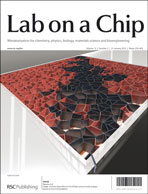The generation of droplets for biological reactions at the microscale can be achieved by many techniques, among which the so-called liquid dielectrophoresis technique (LDEP). This is not a new process, but the parameters influencing actuation voltage still need further insight: size and geometry (electrodes width and gap, dielectric thickness), materials (dielectric constant), liquids (surface tension, dielectric constant, conductivity), working conditions (voltage, frequency) and substrate wettability (contact angle). This large experimental space is firstly reduced using non dimensional numbers and then studied in a systematic way thanks to the design of experiments. The contact angle influence is explained thanks to a new analytical model. To summarize, this paper recalls analytical models used to predict the voltage threshold required to develop a liquid rivulet from a mother drop, taking the contact angle into account and providing a large set of experimental results.
You have access to this article
 Please wait while we load your content...
Something went wrong. Try again?
Please wait while we load your content...
Something went wrong. Try again?


 Please wait while we load your content...
Please wait while we load your content...